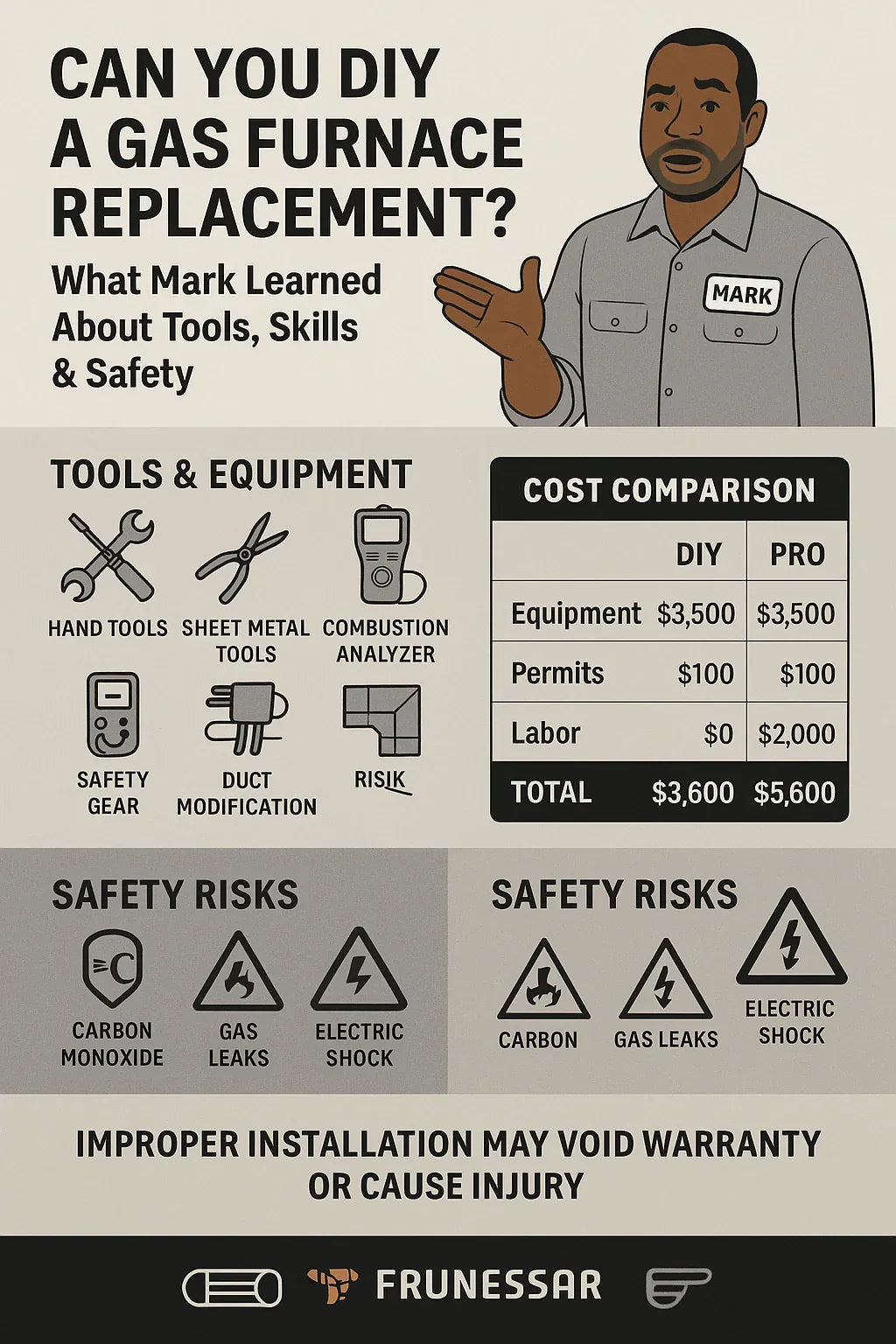1. 🔍 Why This Question Matters
When my old furnace finally coughed its last warm breath in early November, my first thought was:
“I’ve built decks, tiled floors, even rewired a light switch—how hard could it be to replace a furnace?”
A quick search for 100,000 BTU R-32-compatible gas furnaces had me thinking I could save $1,500–$3,000 on labor.
But what I learned over the next week was humbling: furnace replacement isn’t just about muscle and a toolbox—it’s about precision, safety, and legal compliance.
DIY can be tempting, but there’s a fine line between “home improvement project” and “call the fire department.”
2. 🛠 What’s Involved in a Gas Furnace Replacement
Replacing a gas furnace is a multi-step operation involving mechanical, electrical, and fuel system work.
The Steps:
-
Turn off utilities – Gas shutoff, electrical disconnect.
-
Remove old unit – Disconnect ductwork, vent, wiring, gas line.
-
Prepare the space – Check floor leveling, adjust plenum and return air box.
-
Install new furnace – Set in place with correct clearances
-
Reconnect ductwork – Modify and seal with mastic/tape.
-
Connect venting – PVC for high-efficiency, metal flue for standard-efficiency.
-
Reconnect gas line – Leak test with manometer and soap solution.
-
Wire electrical connections – Furnace power, thermostat wiring, safety switches.
-
Commissioning – Test combustion with analyzer, verify temperature rise, set blower speeds.
3. 📋 Tools & Equipment Required
Here’s what I found on my “must-have” list:
Basic Tools:
-
Wrenches, nut drivers, screwdrivers.
-
Cordless drill, bits, extensions.
-
Levels and tape measure.
HVAC-Specific Tools:
-
Sheet metal snips & brake – for duct modifications.
-
Combustion analyzer – to fine-tune air-fuel mix (Energy Star HVAC Guidelines).
-
Manometer – for gas pressure checks.
-
Refrigerant tools (only if handling AC coil replacement—requires EPA Section 608 certification).
Safety Gear:
-
N95 mask or respirator (fiberglass, dust).
-
Safety glasses.
-
Work gloves.
-
Knee pads.
Tool rental alone can add $200–$500 if you don’t already own the specialized gear.
4. 📚 Skills Needed for a Safe Install
Replacing a furnace isn’t just “follow the instructions”—it demands cross-disciplinary skills:
-
Mechanical: Positioning, leveling, fastening, and duct assembly.
-
Gas Plumbing: Black iron or CSST installation, leak detection, regulator adjustments.
-
Electrical: 120V wiring, thermostat control circuits, grounding.
-
Code Literacy: Understanding clearance, venting, and combustion air requirements.
If you’re missing even one of these skills, you risk failed inspections or safety hazards.
5. ⚠️ Safety Hazards & Legal Barriers
This is where my enthusiasm slowed down.
Key Risks:
-
Carbon Monoxide Poisoning: Improper venting can leak deadly CO gas
-
Explosion or Fire: Poor gas connections or wrong pressure settings.
-
Electrical Shock: Incorrect wiring can damage the furnace control board or injure you.
-
Condensate Damage: For high-efficiency models, a clogged drain can flood your utility room.
Legal Barriers:
-
Many states/cities require a mechanical permit for furnace replacement.
-
Gas work often requires a licensed contractor.
-
Manufacturer warranties often void without licensed installation (Goodman Warranty Policy).
6. 🛡 When to Hire a Professional
Even if you want to be hands-on, there are times when a pro is the only smart move.
Hire a Pro For:
-
Installing new gas lines.
-
Routing high-efficiency PVC venting through exterior walls/roof.
-
Setting combustion for optimal efficiency.
-
Integrating with R-32-compatible cooling coils and refrigerant lines.
Hybrid Approach:
Some homeowners do the removal and prep themselves, then have an HVAC tech handle the install, hookup, and commissioning.
7. 💰 Cost Comparison: DIY vs. Pro Install
| Category | DIY Estimate | Professional Install |
|---|---|---|
| Equipment | $2,000–$3,500 | $2,000–$3,500 |
| Tools (purchase/rental) | $200–$500 | N/A |
| Permits | $50–$150 | $50–$150 |
| Labor | Free (your time) | $1,500–$3,000 |
| Total | $2,250–$4,150 | $3,550–$6,650 |
Risk Factor:
One mistake—like improper vent slope—can lead to furnace shutdowns or CO leaks, wiping out your savings.
8. 📌 Mark’s Real-Life Lessons
I ended up:
-
Removing the old furnace myself (saved ~$300 in demo cost).
-
Prepping ductwork and platform ahead of install.
-
Hiring a licensed HVAC tech for gas, vent, and electrical hookups.
-
Passing inspection without a hitch.
The job took:
-
4 hours DIY (demo + prep).
-
6 hours pro install (hookup + commissioning).
That hybrid method gave me the satisfaction of involvement without the life-and-death risks.
9. 🔗 External Resources
Mark’s Final Word:
“Yes, you can replace your own furnace—if you’ve got the right skills, tools, permits, and nerves of steel. But if you mess up, you won’t just void a warranty—you could put lives at risk. My advice? Do the prep, let the pros handle the connections.”
In the next topic we will read more about: Energy Rebates, Tax Credits & Incentives for R-32 Gas Furnaces in 2025







